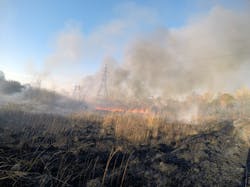Can California Utilities Navigate Customer Backlash Created by Wildfire Prevention Efforts?
California utilities are preparing to thread a very fine needle. The California Public Utilities Commission approved recently a plan to allow utilities to cut off power during extreme weather conditions presenting a high risk of wildfires, such as the combination of high winds and low humidity. But the decision came with some big caveats. Chief among them is that utilities can do a better job educating and notifying the public, particularly the disabled or otherwise vulnerable. While that may seem like a given, the task of balancing public safety needs without compromising customer satisfaction is no small task.
Once power is shut off under emergency conditions, utilities must inspect every de-energized line before restoring power. That is a time-consuming process that can take days. From the perspective of utility customers, this would be inconvenient at best and, at worst, life-threatening.
It’s one thing to endure a couple of nights of California summer with no air conditioning. Things get even more serious when factoring in the needs of utility customers who rely on medications that must stay refrigerated or require breathing assistance from an electric-powered device.
Utilities will face a litany of concerns from customers, yet they have little choice but to deal with this issue head-on.
The 2017 Tubbs Fire in Sonoma County destroyed more than 5600 buildings and caused 27 fatalities. That same year, there were 21 major wildfires in the state of California. The following year was even worse. According to the California Department of Forestry and Fire Protection, the 2018 wildfire season was the deadliest and most destructive wildfire season on record in the state, resulting in 1,893,913 acres being affected. The most destructive of all of these — the Camp Fire, which started in Butte County and burned more than 153,000 acres, destroyed approximately 19,000 structures and killed 85 people — is believed to have been caused by faulty equipment owned and maintained by California’s largest utility, Pacific Gas and Electric Co. (PG&E).
But the PG&E is hardly the only California utility affected by this mounting challenge. The entire west coast, spanning nearly half-a-dozen utilities from San Diego Gas & Electric (SDG&E) to Southern California Edison (SCE) to Pacific Power to Portland General Electric (PGE), are confronting a brave new world of environmental liabilities and customer complaints as they address potential weaknesses in their infrastructure.
There is no question that utilities need to do everything they can to prevent these types of catastrophic disasters. But when it comes to the experience of individual customers, public safety often takes a back seat to convenience and cost.
For example, in 2017, according to the J.D. Power Residential Electric Utility Customer Satisfaction Study, the Tubbs Fire didn’t cause customer satisfaction to drop for the PG&E despite widespread belief that the utility was liable. It wasn’t until 2019 that the PG&E was ultimately found not to be responsible. However, satisfaction declines at the time had little to do with safety or citizenship; they were associated with price increases.
That’s not to say that customers only think inwardly. After the Camp Fire, customers did cite lower citizenship satisfaction with the PG&E. Those drop-offs also were associated with the company’s ensuing bankruptcy. But it does go to show that customers can be influenced by the problem that is most top-of-mind. That creates an opportunity of sorts for west coast utilities to parlay the perceived inconvenience of prophylactic power outages into a public good. As much as forced outages will create new challenges, especially when dealing with vulnerable populations, the trade-off — reducing fear of another catastrophic disaster in which friends, family, and neighbors lose their homes — is worth the effort.
The key is for California utilities to clearly and proactively communicate with their customers about why these safety measures are being taken. One common theme we’ve seen in our utility studies has been that customer awareness of safety initiatives has a high correlation with customer satisfaction. In fact, among electric utility customers, awareness of utility efforts to increase safety is associated with a 112-point increase (on a 1000-point scale) in total satisfaction.
That doesn’t mean it will be easy. The reality for most customers is that dealing with a public safety power shutoff, or a price increase, is far more tangible than a wildfire that may never happen. And while customers may be able to tolerate their bill going up a few dollars a month, living under the constant fear that a machine that they may need could turn off while sleeping could be debilitating. Asking customers to rely on a utility to keep them educated and provide assistance in the case of an emergency shutoff is a big request. But utilities that deliver effectively on that promise will be in a unique position to form strong bonds with their customers.
Ultimately, it’s a large burden that must fall on utilities, one that, even under the best of circumstances, may not result in many clear victories.
California utilities have to embrace any and every tool at their disposal to educate the public and keep them informed of the realities of these shutoffs. Not only does the service of thousands of customers hinge on it, many have their lives on the line as well.
J.D. Power is a T&D World media partner.
About the Author
Andrew Heath
Dr. Andrew Heath is the Managing Director of the Utility Practice and Senior Director of utilities intelligence at J.D. Power. He is responsible for J.D. Power’s water, natural gas, and electric customer satisfaction studies in the United States and Canada, as well as the company’s Utility Digital Experience Study. Dr. Heath has more than 30 years of experience working within the utility and infrastructure sectors in both the United States and the UK.
